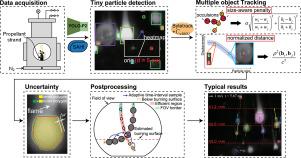Deep learning-based analysis of aluminum particle trajectory and spatial size-velocity correlation in solid propellant combustion at 6 MPa
IF 4.6
2区 工程技术
Q2 ENGINEERING, CHEMICAL
引用次数: 0
Abstract
Characterizing particle size, position, and velocity, particularly under elevated pressure, is crucial for understanding the underlying combustion dynamics and optimizing propellant formulations to enhance rocket propulsion efficiency. This study presents a deep learning-based data analysis method designed for the detection, tracking, and diameter uncertainty assessment of blurred combustion aluminum particles captured by microscopic imaging. The methodology employs a fine-tuned You Only Look Once model, enhanced by Slicing Aided Hyper Inference, to accurately detect aluminum particles, especially smaller ones. Weighted Distance Intersection over Union is proposed for robust tracking in scenarios with high particle concentrations. Innovatively, a Gaussian kernel-based blur estimation technique is introduced to quantify the uncertainty in particle size measurements. Qualitative and quantitative evaluation experiments have demonstrated the effectiveness of this method. Furthermore, time-resolved individual particle dynamics and spatial particle size and velocity profiles were thoroughly explored using frames captured from a single propellant strand burning test at 6 MPa. Two coupled physical mechanisms underlying particle size dynamics were discovered, while the multimodal behavior of combustion aluminum particles was further analyzed in depth. This research successfully expands the applicability of microscopic imaging, presenting an approach to studying combustion mechanisms under high-pressure conditions.

基于深度学习的6 MPa固体推进剂燃烧铝颗粒轨迹及空间尺寸-速度相关性分析
表征颗粒的大小、位置和速度,特别是在高压下,对于理解潜在的燃烧动力学和优化推进剂配方以提高火箭推进效率至关重要。本研究提出了一种基于深度学习的数据分析方法,用于显微成像捕获的模糊燃烧铝颗粒的检测、跟踪和直径不确定度评估。该方法采用了经过微调的“你只看一次”模型,并通过切片辅助超推断得到增强,以准确地检测铝颗粒,特别是较小的铝颗粒。提出了一种基于Union的加权距离交叉点算法,用于高粒子浓度场景下的鲁棒跟踪。创新性地引入了一种基于高斯核的模糊估计技术来量化粒度测量中的不确定性。定性和定量评价实验证明了该方法的有效性。此外,通过从6 MPa下的单一推进剂链燃烧试验中捕获的帧,深入探索了时间分辨的单个颗粒动力学和空间颗粒大小和速度分布。发现了两种耦合的物理机制,并进一步深入分析了燃烧铝颗粒的多模态行为。本研究成功扩展了显微成像的适用性,为研究高压条件下的燃烧机理提供了一种方法。
本文章由计算机程序翻译,如有差异,请以英文原文为准。
求助全文
约1分钟内获得全文
求助全文
来源期刊

Powder Technology
工程技术-工程:化工
CiteScore
9.90
自引率
15.40%
发文量
1047
审稿时长
46 days
期刊介绍:
Powder Technology is an International Journal on the Science and Technology of Wet and Dry Particulate Systems. Powder Technology publishes papers on all aspects of the formation of particles and their characterisation and on the study of systems containing particulate solids. No limitation is imposed on the size of the particles, which may range from nanometre scale, as in pigments or aerosols, to that of mined or quarried materials. The following list of topics is not intended to be comprehensive, but rather to indicate typical subjects which fall within the scope of the journal's interests:
Formation and synthesis of particles by precipitation and other methods.
Modification of particles by agglomeration, coating, comminution and attrition.
Characterisation of the size, shape, surface area, pore structure and strength of particles and agglomerates (including the origins and effects of inter particle forces).
Packing, failure, flow and permeability of assemblies of particles.
Particle-particle interactions and suspension rheology.
Handling and processing operations such as slurry flow, fluidization, pneumatic conveying.
Interactions between particles and their environment, including delivery of particulate products to the body.
Applications of particle technology in production of pharmaceuticals, chemicals, foods, pigments, structural, and functional materials and in environmental and energy related matters.
For materials-oriented contributions we are looking for articles revealing the effect of particle/powder characteristics (size, morphology and composition, in that order) on material performance or functionality and, ideally, comparison to any industrial standard.
 求助内容:
求助内容: 应助结果提醒方式:
应助结果提醒方式:


